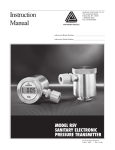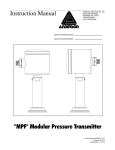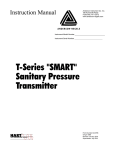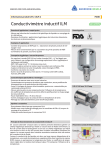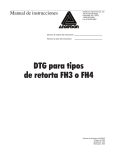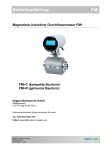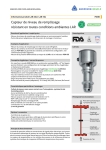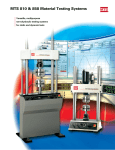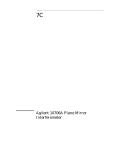Download Instruction Manual - Anderson
Transcript
Instruction Manual Anderson Instrument Co. Inc. 156 Auriesville Road Fultonville, NY 12072 1-800-833-0081 Fax 518-922-8997 www.anderson-negele.com Instrument Model Number_________________________________ Instrument Serial Number ____________________________________ HA SANITARY ELECTRONIC PRESSURE TRANSMITTER Form Number #2005 © December 1997 Rev. 11/00 PAGE 2 Table of Contents Page Number SECTION 1 - INTRODUCTION 3 1.1 SPECIFICATIONS 3 SECTION 2 - THEORY OF OPERATION 5 SECTION 3 - INSTALLATION 5 SECTION 4 - SENSOR WIRING 6 SECTION 5 - INSTRUMENT WIRING 7 5.1 LOOP POWER 7 SECTION 6 - MAINTENANCE & CALIBRATION 8 6.1 CALIBRATION OF TRANSMITTER 8 SECTION 7 - TROUBLESHOOTING 9 7.1 VOLTAGE CHECK 7.2 CURRENT CHECK 7.3 MISCELLANEOUS TROUBLESHOOTING 9 9 9 SECTION 8 - WARRANTY AND RETURN STATEMENT 10 FIGURES 1 2 3 4 Dimensional View Wiring Terminal Connections Loop Power Guidelines Loop Diagram 3 6 7 7 PAGE 3 Section 1 - Introduction This manual has been designed to assist the end-user with the installation of the Anderson model HA Sanitary Electronic Pressure Transmitter. When followed properly, your sensor will provide optimum performance with minimum maintenance. FIGURE 1 - Dimensional View 1.1 SPECIFICATIONS Excitation: 10-40 VDC (Absolute), 24 VDC Nominal regulated or unregulated. Output: 4-20 mA DC, 2 wire with non-interrupting circuit verification test points Loop Resistance: 0-700 ohms at 24 VDC Wiring Connection: 16 AWG max.; Screw Terminal; Accessible via removable screw cap conduit housing Recommended Cable: 22-24 AWG, foil shielded, and PVC coated. (3/16 - 1/4 OD insulation) Accuracy: ± 0.5% of Full Scale Repeatability: ± 0.3% of full scale Hysteresis: ± 0.25% of full scale PAGE 4 Linearity: ±0.10% of full scale Stability: ±.25% of calibrated range/6 months Storage Temperature: -40° to 149°F (-40°C to 65°C) Process Temperature Limits: 30 to 300°F (-1°C to 149°C) (Horizontal Mount recommended over 275°F) Ambient Temperature Limits: 40 to 120° F (4 to 49°C) Effect of Temperature Change: ± 0.1 psig/10°F typical Over-Range Rating: 2 times base range Wetted Parts: 316L stainless steel electropolished (Ra max. = 8 microinches, .2 microns) Housing Material: 304 Stainless Steel Zero and Span Adjustments: ± 10% of range Mounting: Direct connection * Specifications are subject to change without notice PAGE 5 Section 2 - Theory of Operation The Anderson HA Pressure Transmitter can be utilized for applications in which a process variable of pressure must be converted to an electronic signal. This unit utilizes an internal pressure transducer to convert the process measurement into a corresponding mV signal. The mV signal then passes through custom linearization and conditioning circuitry. The resulting signal is an industry standard 4-20 mA. This mA signal is factory set over the specified range of the unit. From here the signal may be sent to an Anderson digital display, Microprocessor based controller, chart recorder, or customer supplied instrumentation. Section 3 - Installation The physical installation is the most important concern with regards to promoting sensor reliability. Sensors must be installed in such a way that the housing and cable are not subject to physical abuse. In addition, moisture or moist air must not be allowed to enter the sensor housing or cable. NOTE: The installer assumes responsibility for preventing water or water- vapor from entering the sensor housing. Your new HA transmitter is supplied with a conduit housing. If mounted horizontally, the conduit connection should point downward. Also, to prevent entry of excessive moisture, it is highly recommended that flexible conduits not be connected directly to the sensor. If conduit is to be run to the sensor, it is preferable that the watertight connector provided with each sensor not be removed from the sensor. Instead, run the flexible conduit as near to the sensor as possible and utilize a seal-tight connector at the end of the conduit. Allow a short amount of cable to run between the sensor and the flexible conduit. This isolates the sensor housing from the conduit system and any moisture it may contain. If the conduit is connected directly to the sensor, the chances are high that the sensor will eventually fail due to excessive water or water vapor entry into the housing. NOTE: It is recommended that a sensor "ZERO" be performed at time of installation. Refer to section 6.1 for information on this procedure. PAGE 6 Section 4 - Sensor Wiring Anderson recommends a cable of 24 gauge, 4 conductor, shielded (Belden #9534) or equivalent. Four conductor cable is utilized because of its roundness, which provides a suitable seal when used with seal-tight connectors, strain reliefs and rubber grommets. Irregular shaped cable does not allow for a watertight seal. If utilizing customer supplied cable, select a round cable with 22-24 AWG wire and a shield. In order for the Anderson provided seal-tight connector to seal on the cable, the O.D. of the cable must be between 3/16" and 1/4". If smaller cable is utilized, a different neoprene bushing must be used (must be customer supplied). If an alternate seal-tight type connector is going to be used, be absolutely certain that the rubber bushing will adequately seal on the cable. Do not use a connector intended for power cable (large inside diameter) if the sensor cable is only 1/4". Be sure to use Teflon thread tape when attaching the new seal-tight connector. Wiring to the conduit housing sensor is accomplished as follows: 1. Remove the housing cap to expose the wiring terminal block. 2. Insert the cable through the seal-tight connector, stripping back approximately 2 inches of sheathing to expose the wires. 3. Two wires will be utilized for connections at the transmitter end of the loop. Normal color codes being RED (Loop +) and BLACK (Loop -). Trim off all unused wires, including the bare shield ground wire. To prevent a GROUND LOOP condition, be sure the shield material and the shield ground wire do not touch the sensor housing. Use an insulator such as electrical tap or heat shrink tubing if necessary. 4. Strip the tips of the remaining wires back approximately 3/8 of an inch and twist strands (tinning is highly recommended). 5. Using Figure 2, make the proper connections to the wiring terminal strip (located inside the conduit housing) Figure 2 - Wiring Terminal Connections PAGE 7 Section 5 - Instrument Wiring With the proper wiring connections made at the senor end of the loop, it is now time to make final connections at the instrument end of the loop. The HA may feed instruments such as an Anderson digital display, microprocessor based controller, chart recorder, or customer supplied instrumentation. 5.1 LOOP POWER The Anderson HA requires loop power for operation. Ratings are as follows: HA Transmitter: 10-40 VDC (Absolute), 24 VDC Nominal, regulated or unregulated As inherent resistance associated with cable length and signal receiver input may affect operation of the transmitter, Figure 3 shows some guidelines for loop power required. FIGURE 3 - Loop Power Guidelines Please consult the Installation/Service Manual that was provided with your receiver for specific wiring instruction. Most Anderson receivers (displays, chart recorders, etc.) are capable of supplying loop power. Typical wiring would be as follows: Figure 4 - Loop Diagram PAGE 8 Section 6 - Maintenance & Calibration Anderson electronic sensors require very little maintenance. We suggest that the sensor be inspected at 6 month intervals to ensure that it is not being physically abused, moisture is not entering the housing, and that the wiring is sound. If you feel that the output of the HA transmitter is not correct, calibration of the unit may be required. Section 6.1 illustrates the procedures for calibration of the transmitter. Equipment required: Pressure source Accurate reference gauge DC Milliamp Meter (accurate to .01 mA) Small straight blade screwdriver Calculator 6.1 CALIBRATION - TRANSMITTER Adjustments to the transmitter are made via the "ZERO" and "SPAN" potentiometers. These two adjustments are non-interactive, meaning changing the zero will not change the span. As general maintenance to the unit, a zero check is recommended at approximately 6 month intervals. If your unit is calibrated at a compound range, you will not see 4.00 mA at atmospheric zero. As reference, you may use the following chart to determine if your unit may require calibration (most common ranges are shown). Sensor Range 0-psig - Positive Pressure 0 psig - 30" Hg 30" Hg - 15 psig 30" Hg - 30 psig 30" Hg - 60 psig 30" Hg - 100 psig Sensor Reads at Atmospheric Zero 4.00 mA 20.00 mA 11.92 mA 9.26 mA 7.15 mA 6.05 mA The output of a properly calibrated transmitter may be calculated by using the following formula: [ mA Output = 16 x [ (KNOWN VALUE - LOW END OF RANGE ) TRANSMITTER SPAN ]]+ 4 NOTE: The transmitter should be wired in a complete loop at this point, or on a test bench and configured per the diagram shown in Figure 4, page 7. Although no interaction between zero and span occurs, when making adjustments you should be as close to the top and bottom transmitter range as possible. This will ensure the best possible linearity in the final signal output. 1. Expose the transmitter to a known zero reference point. If transmitter range starts at atmospheric zero, zero adjust at atmospheric zero. If transmitter is a compound range, you should be as close to sensor zero as possible . You must calculate the expected mA signal (use formula proved at start of this section). 2. Remove cap from transmitter. 3. With your meter set to DC mA, connect the RED (Meter +) lead to the (TP +) terminal. Connect the BLACK (Meter - ) lead to the (TP -) terminal. (See Figure 2) 4. Adjust the transmitter ZERO potentiometer as shown in Figure 2, until you either see 4.00 mA if you are at atmospheric zero, or your expected mA signal for a compound range. PAGE 9 5. Expose the transmitter to a know process variable near the top end of the range. 6. Again, using the formula provided, calculate the mA reading expected. 7. Adjust the transmitter SPAN potentiometer, as shown in Figure 2, until you see your expected mA output. NOTE: For pressure transmitters with compound ranges, the ranges must first be converted to all one type unit of measure. For example, a 30" Hg/0/30 psig unit may be considered to have a range of -14.7 psig-0-30 psig and a span of 44.7 psig (2.036" Hg = 1 psi). Be careful not to lose the (-) sign while performing the calculation of the proper reading. Section 7 - Troubleshooting 7.1 VOLTAGE CHECK Using a digital multimeter on the DC volts scale and with the sensor connected to the receiver, confirm that the sensor is being provided the correct loop power. Place the RED (Meter +) lead on the (Loop +) terminal, and the BLACK (Meter -) lead on the (Loop -) terminal. You should see between 10-40 VDC for a standard transmitter. 7.2 CURRENT CHECK To check the mA loop, be sure the sensor is connected to the receiver. Open the cap on the transmitter to expose the wiring terminals. Using a digital multimeter on the mADC scale, connect the RED (Meter +) lead to the (TP +) terminal and the BLACK (Meter -) lead to the (TP -) terminal. You will be reading the mA current loop. A high current flow, approaching 30 mA, indicates a problem with the transmitter (internal short). If no current flow is observed this indicates either an open loop or a problem with the transmitter. To check a transmitter at a know pressure, refer to the Calibration section for information on how to properly calculate the mA output at the known value. 7.3 MISCELLANEOUS TROUBLESHOOTING Symptom When testing Loop, NO current flow detected Action • Check for broken connections • Check loop wiring (incorrect polarity affects loop) Feel free to contact Anderson Technical Services Department at 1-800-833-0081 for further assistance with troubleshooting. PAGE 10 Section 8 - Warranty and Return Statement These products are sold by The Anderson Instrument Company (Anderson) under the warranties set forth in the following paragraphs. Such warranties are extended only with respect to a purchase of these products, as new merchandise, directly from Anderson or from an Anderson distributor, representative or reseller, and are extended only to the first buyer thereof who purchases them other than for the purpose of resale. Warranty These products are warranted to be free from functional defects in materials and workmanship at the time the products leave the Anderson factory and to conform at that time to the specifications set forth in the relevant Anderson instruction manual or manuals, sheet or sheets, for such products for a period of one year. THERE ARE NO EXPRESSED OR IMPLIED WARRANTIES WHICH EXTEND BEYOND THE WARRANTIES HEREIN AND ABOVE SET FORTH. ANDERSON MAKES NO WARRANTY OF MERCHANTABILITY OR FITNESS FOR A PARTICULAR PURPOSE WITH RESPECT TO THE PRODUCTS. Limitations Anderson shall not be liable for any incidental damages, consequential damages, special damages, or any other damages, costs or expenses excepting only the cost or expense of repair or replacement as described above. Products must be installed and maintained in accordance with Anderson instructions. Users are responsible for the suitability of the products to their application. There is no warranty against damage resulting from corrosion, misapplication, improper specifications or other operating condition beyond our control. Claims against carriers for damage in transit must be filed by the buyer. This warranty is void if the purchaser uses non-factory approved replacement parts and supplies or if the purchaser attempts to repair the product themselves or through a third party without Anderson authorization. Returns Anderson’s sole and exclusive obligation and buyer’s sole and exclusive remedy under the above warranty is limited to repairing or replacing (at Anderson’s option), free of charge, the products which are reported in writing to Anderson at its main office indicated below. Anderson is to be advised of return requests during normal business hours and such returns are to include a statement of the observed deficiency. The buyer shall pre-pay shipping charges for products returned and Anderson or its representative shall pay for the return of the products to the buyer. Approved returns should be sent to: ANDERSON INSTRUMENT COMPANY INC. 156 AURIESVILLE ROAD FULTONVILLE, NY 12072 USA ATT: REPAIR DEPARTMENT PAGE 11 PAGE 12 ANDERSON INSTRUMENT CO., INC • 156 AURIESVILLE RD. • FULTONVILLE, NY 12072 • USA • 800-833-0081 • FAX 518-922-8997 ANDERSON INSTRUMENT CO. LP • 400 BRITANNIA RD. EAST, UNIT 1 • MISSISSAUGA, ONTARIO L4Z 1X9 • CANADA • 905-603-4358 • FAX 905-568-1652 NEGELE MESSTECHNIK GmbH • RAIFFEISENWEG 7 • D-87743 EGG A. D. GÜNZ • GERMANY • +49 (0) 8333/9204-0 • FAX +49 (0) 8333/9204-49 www.anderson-negele.com












